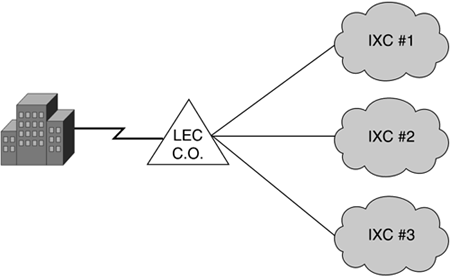Voice Network Access
There are two methods available to support access from (and termination to) a customer premise to the PSTN switched and dedicated.
Switched access to the PSTN describes a customer implementation where a long-distance carrier either is pre-subscribed to by the caller or is identified by additional digits, called the Carrier Identification Code (CIC) to the dialed number. Switched access is beneficial to the customer in environments with small call volumes where dedicated access does not provide a cost-savings.
Dedicated access to the PSTN describes a customer implementation where a dedicated circuit, or line, is provisioned between the customer site and the telephone switch. Dedicated access provides a cost-per-minute savings to the customer and is beneficial to the customer in environments with large call volumes.
NOTEDedicated access can terminate into either a local or long-distance telephone switch, depending upon the network service provider being a local or long-distance carrier. |
Aside from switched and dedicated access, there are two additional distinctions regarding access to a long-distance, or interexchange, carrier; the CIC and Primary Interexchange Carrier (PIC), as described below:
CIC The CIC is a 4-digit code that controls the routing applied to a call by the originating switch. The CIC is also a numeric code assigned by the NANP Administrator for the provisioning of switched services. The CIC is unique to each carrier and is used by the telephone company to route a call to the trunk group designated by the CIC.
PIC The PIC is a code identifying a carrier chosen by a subscriber (a customer or end-user, for example) to be accessible via simplified dialing pattern, such as '8+Dialed Number' from a Private Branch Exchange (PBX).
Switched Access
Switched access to a long-distance IntereXchange Carrier (IXC) is dependant on the customer establishing a connection between themselves and the Local Exchange Carrier (LEC) and interconnecting trunks between the serving LEC and the IXC.
When the customer (end-user) places an outbound long-distance call, the LEC performs a database lookup to determine which long-distance carrier, or IXC, the route should be called to. The LEC's customer determines which IXC will carry the call by use of the Primary Interexchange Carrier Code (PIC). The LEC translates this PIC to a CIC determining which carrier will receive the dialed long-distance call from the end-user.
Figure 17-1 illustrates a typical switched access configuration. Switched access is physically a single 2- or 4-wire line from a telephone set directly connected to a LEC Central Office (C.O.) switch. It is possible for a customer premise to have several switched access lines, with groups of these switched access lines having different IXCs being selected as the primary carrier.
Figure 17-1. Switched Access

Switched access is typically found in a small office/home office (SOHO) environment where call usage is fairly low. The alternative to switched access is dedicated access, which is discussed in the next section.
NOTEIf a customer location has seven or more switched access lines it is worth considering a dedicated access option, such as a T1, to reduce costs. |
Dedicated Access
Dedicated long-distance access bypasses the LEC CO switch and connects the customer directly to the IXC. Dedicated access is typically seen in environments where call volume to a particular customer premise may be very high, such as large enterprise locations or call centers.
Because dedicated access is a straight-through facility as far as the LEC is concerned and not consuming switch capacity in the LEC voice switch, dedicated access tends to be more cost effective on a per-call basis. In a long-distance configuration, such as illustrated in Figure 17-2, the customer does not need to negotiate with the LEC at all. Instead the serving IXC will interface with the serving LEC on the customer's behalf.
Figure 17-2. Dedicated Access

The physical connection in a dedicated access environment is typically DS1/DS3 between the customer premise and the IXC. In a dedicated environment only one IXC can support each physical line (DSx), however, the customer premise can have several physical lines going to several IXCs, with the PBX making the determination which IXC is to carry the call (based on PBX configuration).
EAN: 2147483647
Pages: 269